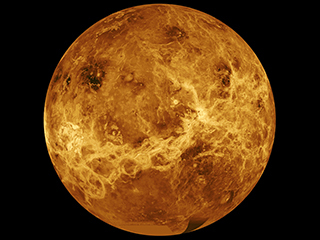
Venus is the second planet from the Sun. It is named after the Roman goddess of love and beauty. As the brightest natural object in Earth's night sky after the Moon, Venus can cast shadows and can be, on rare occasion, visible to the naked eye in broad daylight.
Distance from Sun: 67.24 million mi Orbital period: 225 days Length of day: 116d 18h 0m Surface area: 177.7 million mi² Radius: 3,760.4 mi
Did you know that Venus shows phases? Through a telescope, it can look like a tiny, featureless waning or waxing moon. At this writing (late February 2020), Venus is in a waning gibbous phases. In other words, telescopic observers are seeing it as more than half lighted, but less than full.
The interior of Venus is made of a metallic iron core that's roughly 2,400 miles (6,000 km) wide. Venus' molten rocky mantle is roughly 1,200 miles (3,000 km) thick. Venus' crust is mostly basalt, and is estimated to be 6 to 12 miles (10 to 20 km) thick, on average. Venus is the hottest planet in the solar system.
, although being the 2nd closest to the sunDid you know that Venus shows phases? Through a telescope, it can look like a tiny, featureless waning or waxing moon. At this writing (late February 2020), Venus is in a waning gibbous phases. In other words, telescopic observers are seeing it as more than half lighted, but less than full.
The interior of Venus is made of a metallic iron core that's roughly 2,400 miles (6,000 km) wide. Venus' molten rocky mantle is roughly 1,200 miles (3,000 km) thick. Venus' crust is mostly basalt, and is estimated to be 6 to 12 miles (10 to 20 km) thick, on average. Venus is the hottest planet in the solar system.